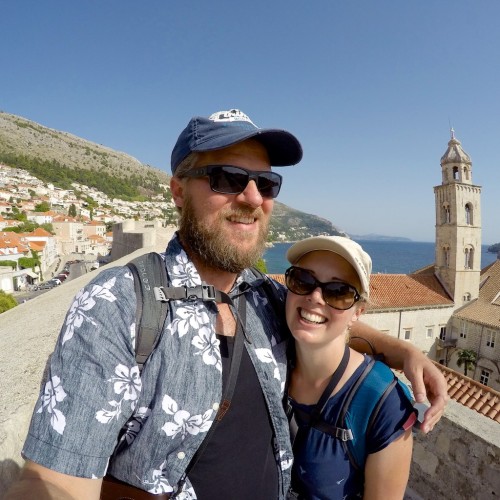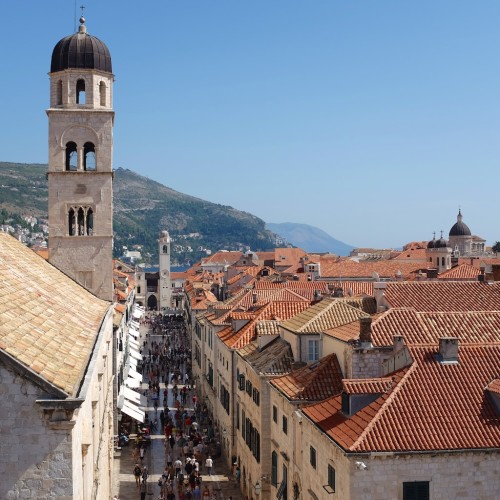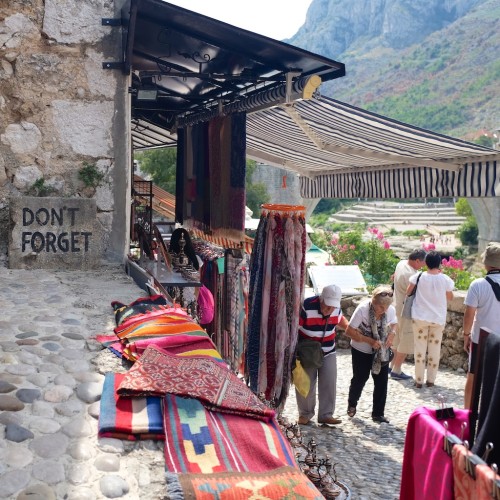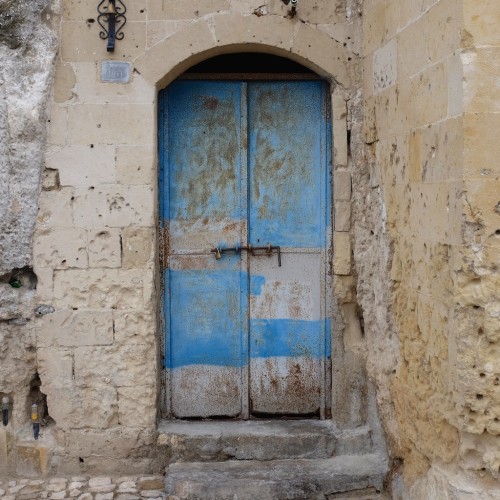
Week 6: Turning Point
After boarding the Jadrolinija ferry at Dubrovnic we were slightly delayed due to extra checks at customs. The emerging (so called) “migrant crisis” in Europe and in particular on the borders of Croatia at the time of this writing, resulted in several borders being closed and extra measures being implemented at others.
The ferry started vibrating from the engines and moved slowly out of the harbour. It leaned heavily to port side. Nobody seemed alarmed although by this time the alcohol was flowing freely and on one deck lower a group of people crowded around a guitar player and were singing Italian folk songs and drinking beer and wine. Perhaps to get courage for the night ahead? We finished our drinks and went searching for a cabin. It was the cheapest available. Three decks below water level and right at the front of the ship. Sarah fell asleep immediately. I took a little longer whilst listening to the humming of the ship’s engine and the sound of splashing water as the ship parted the surface of the Adriatic, and contemplated how likely a leaning ferry dating from the 1950’s are to make a seven hour crossing to Bari, Italy.
Our route took us from Jelsa on the island of Hvar, to Dubrovnic, Mostar (Bosnia & Herzegovona), and to the south of Italy. In Italy we arrived by ferry to the city of Bari and travelled to the heel of the boot at Fontanelle and then back up to the wonderful city of Matera and on to Nerano on the Amalfi Coast, our current location.
Our route during week 6 from the Island of Hvar in Croatia to the Amalfi Coast in Italy.
Croatia
We decided to make Dubrovnic our turning point. It’s not the furthest east we’ve been, nor was it the furthest south, but it made sense to turn here as we’ve just gone over the half-way mark in terms of time. We didn’t want to quicken our pace and we knew we would have to if we went any further and still want to make it back to England in time.
Dubrovnic old town is a hectic stampede of stag/hen do’s and tourists cruise-shipped in from various parts of the world. And they arrived early. We headed to the city walls for a relatively crowd free circle of the old town. We were lucky. It was unusually hot for the time of year and the crowds preferred the shaded alleys to the scorching heat on top of the walls. The views of Dubrovnic was beautiful and at several points along the route there are shaded coffee shops and juice bars. Approximately sixty percent of the city was destroyed during the 1990’s war, but since then it was completely rebuilt. The untarnished roof tiles a testament to that. Everything in the old town revolves around tourism and one could even do a Game of Thrones tour, Dubrovnic standing in as King’s Landing in the TV series. We too can now say we stepped off the stone pier at King’s Landing and sailed off to far lands (Mlini’s old fishing harbour in our case).
We stayed outside of Dubrovnic in what once was the tiny fishing village of Mlini, eight kilometers south of Dubrovnic. These days it’s one of the crown jewels on the Croatian Riviera, though we still managed to find an excellent camping spot at Kamping Kate just above the stone harbour. The site’s been there in its present form for fifteen years, but before that the owner’s grandfather also ran a campsite around the neighbouring house for a long time. We now camped under a gigantic fig tree in what once was the fruit orchard. Time and time again we found that the best campsites were those sites with some family history or some family connection with the place – Kamping Kate no exception.
Around Mlini it was striking yet again how much of Croatia was damaged during the war with various abandoned hotels still full of gaping wounds from bullets and mortar rounds. There’s a lot of politics around these abandoned places and understandingly people don’t really talk or want to talk about it.
Bosnia & Herzegovina
It’s hard to imagine that Bosnia & Herzegovina and Croatia were once upon a time part of the same country. It couldn’t be worlds further apart. The roads isn’t as bad as everyone warned, but the traffic was hectic. We also had to brave 40 degrees Celsius heat, but it was completely worth it. Mostar is quite touristic, but is easily reached from Dubrovnic or other places in Croatia on the coast.
Italy
Arriving in Italy meant we were on the going back leg of our tour. It evoked mixed feelings. Sadness that we’ve turned and that there would be some places left unseen. Excitement as there are so many new places to discover in Italy and on the rest of our route. A sense of familiarity as we’ve been several times before, yet wonderment to the uniqueness of southern Italy. It almost doesn’t feel like Europe at all. The city of Matera in particular was a unexpected surprise. There are tourists, but mostly from Italy. We did not expect to find such an unspoilt place still in Italy. We stayed for one night in a cave dwelling (the excellent B&B La Corte) before heading further west to the Amalfi Coast.
Trip stats (Week 1 – Week 6):
- Current location: Amalfi Coast, Italy
- Days on the road: 42
- Distance travelled: 5 123.2 km
- Countries visited: Belgium, Luxembourg, Germany, Switzerland, Lichtenstein, Austria, Slovenia, Croatia, Bosnia & Herzegovina
- Cups of coffee: 92
- Pitched the tent 5 times.
- Camper awning pitched 13 times.
- Number of campsites: 24
- Number of B&B’s: 1
- Average weekly cost for camping: £127.56
- Average weekly cost for diesel: £34.51
- Average weekly cost for food & groceries: £72.31
- Average weekly cost for ferries, tolls, parking and public transport: £58.08
- Average weekly cost for entertainment, museums, and other attractions: £43.77




























